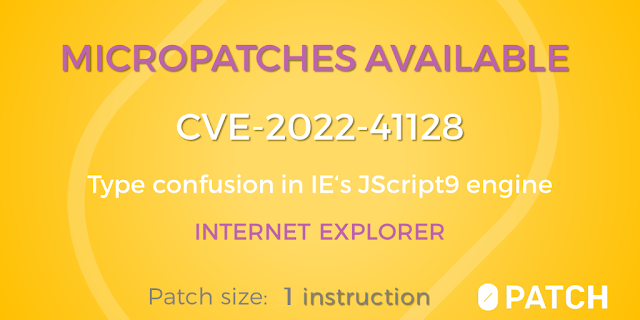With November 2022 Windows Updates, Microsoft fixed a vulnerability in Internet Explorer's JScript9 engine that was found being exploited by North Korean government-backed actors known as APT37. The vulnerability is of a "type confusion" sort, which means that malicious JavaScript code can confuse the JavaScript engine into thinking that a certain object is of one type (in our case, Int32Array) while it's actually of another type (in our case, Object) - and that quickly leads to reading or writing memory addresses that were not supposed to be available to said code. From that point on, arbitrary code execution can be achieved.
Benoît Sevens and Clément Lecigne of Google's Threat Analysis Group (TAG) have written a very good analysis of this vulnerability including a minimized proof of concept. This made it possible for us to create a patch for affected "security-adopted" Windows systems that no longer receive official fixes from Microsoft.
Microsoft assigned this issue CVE-2022-41128 and fixed it by removing a code branch that was dependent on a call to function ShouldExpectConventionalArrayIndexValue; in the patched code, this function call is skipped so the code always continues down the same path.
Admittedly, we did not investigate what really went wrong with this vulnerable code and just logically replicated Microsoft's patch as we trust they know what they're doing. Our
micropatch thus only has one instruction that jumps over the now-excluded code:
MODULE_PATH "..\Affected_Modules\jscript9.dll_11.0.9600.19597_Win7_64-bit_NoESU\jscript9.dll"
PATCH_ID 1192
PATCH_FORMAT_VER 2
VULN_ID 7598
PLATFORM win64
patchlet_start
PATCHLET_ID 1
PATCHLET_TYPE 2
PATCHLET_OFFSET 0x2156e
N_ORIGINALBYTES 5
JUMPOVERBYTES 0
PIT jscript9.dll!0x21581
code_start
jmp PIT_0x21581 ; jump over the excluded code block
code_end
patchlet_end
The micropatch was written for the following Versions of Windows with all available Windows Updates installed:
- Windows 10 v2004
- Windows 10 v1909
- Windows 10 v1809
- Windows 10 v1803
- Windows 7 without ESU, with year 1 of ESU and with year 2 of ESU
- Windows Server 2008 R2 without ESU, with year 1 of ESU and with year 2 of ESU
To learn more about 0patch, please visit our Help Center. For a trial or demo please contact sales@0patch.com.
We'd like to thank Benoît Sevens and Clément Lecigne of Google's Threat Analysis Group (TAG) for publishing their analysis and providing a proof-of-concept that allowed us to reproduce the vulnerability and create a micropatch. We also encourage security researchers to privately share their analyses with us for micropatching.

No comments:
Post a Comment